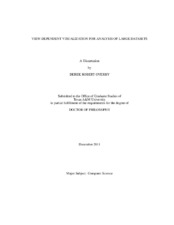| dc.contributor.advisor | Keyser, John | |
| dc.creator | Overby, Derek Robert | |
| dc.date.accessioned | 2012-02-14T22:20:16Z | |
| dc.date.accessioned | 2012-02-16T16:18:07Z | |
| dc.date.available | 2012-02-14T22:20:16Z | |
| dc.date.available | 2012-02-16T16:18:07Z | |
| dc.date.created | 2011-12 | |
| dc.date.issued | 2012-02-14 | |
| dc.date.submitted | December 2011 | |
| dc.identifier.uri | https://hdl.handle.net/1969.1/ETD-TAMU-2011-12-10501 | |
| dc.description.abstract | Due to the impressive capabilities of human visual processing, interactive visualization methods have become essential tools for scientists to explore and analyze large, complex datasets. However, traditional approaches do not account for the increased size or latency of data retrieval when interacting with these often remote datasets. In this dissertation, I discuss two novel design paradigms, based on accepted models of the information visualization process and graphics hardware pipeline, that are appropriate for interactive visualization of large remote datasets. In particular, I discuss novel solutions aimed at improving the performance of interactive visualization systems when working with large numeric datasets and large terrain (elevation and imagery) datasets by using data reduction and asynchronous retrieval of view-prioritized data, respectively.
First I present a modified version of the standard information visualization model that accounts for the challenges presented by interacting with large, remote datasets. I also provide the details of a software framework implemented using this model and discuss several different visualization applications developed within this framework.
Next I present a novel technique for leveraging the hardware graphics pipeline to provide asynchronous, view-prioritized data retrieval to support interactive visualization of remote terrain data. I provide the results of statistical analysis of performance metrics to demonstrate the effectiveness of this approach.
Finally I present the details of two novel visualization techniques, and the results of evaluating these systems using controlled user studies and expert evaluation. The results of these qualitative and quantitative evaluation mechanisms demonstrate improved visual analysis task performance for large numeric datasets. | en |
| dc.format.mimetype | application/pdf | |
| dc.language.iso | en_US | |
| dc.subject | interactive visualization | en |
| dc.subject | asynchronous data retrieval | en |
| dc.subject | view-dependent prioritization | en |
| dc.title | View-Dependent Visualization for Analysis of Large Datasets | en |
| dc.type | Thesis | en |
| thesis.degree.department | Computer Science and Engineering | en |
| thesis.degree.discipline | Computer Science | en |
| thesis.degree.grantor | Texas A&M University | en |
| thesis.degree.name | Doctor of Philosophy | en |
| thesis.degree.level | Doctoral | en |
| dc.contributor.committeeMember | Childs, Selma | |
| dc.contributor.committeeMember | Shipman, Frank | |
| dc.contributor.committeeMember | Wall, Jim | |
| dc.contributor.committeeMember | Srinivasan, Vinod | |
| dc.type.genre | thesis | en |
| dc.type.material | text | en |


